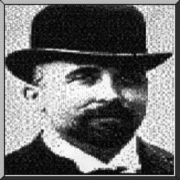 Felix
Hoffmann, a German chemist born in 1867, produced a
stable form of acetylsalicylic acid, or more commonly known as
aspirin, on August 10, 1897. For the past 100 years, it is estimated
that one trillion aspirin have been consumed worldwide in order to
relieve aches and pains, reduce fevers, fight inflammation, and help
fight against cardiovascular disease.
Felix
Hoffmann, a German chemist born in 1867, produced a
stable form of acetylsalicylic acid, or more commonly known as
aspirin, on August 10, 1897. For the past 100 years, it is estimated
that one trillion aspirin have been consumed worldwide in order to
relieve aches and pains, reduce fevers, fight inflammation, and help
fight against cardiovascular disease.
Hoffmann, a chemist with Friedrich Bayer & Co., Elberfeld, Germany, began seeking to find such a pain reliever in order to help ease his father's debilitating rheumatism. Two thousand years before his discovery, Hippocrates, a Greek physician, had discovered that chewing on willow bark would relieve pain and fever. Eventually, scientists discovered that this "magic stuff" was actually salicin; however, salicyclic acid, which is derived from the willow bark, can upset the stomach. In 1853, Charles Frederic Gerhardt, a French chemist, produced a new compound (that would be less irritating to the stomach) by combining sodium salicylate (sodium had been combined in order to help neutralize the salicylic acid) with acetyl chloride. Unfortunately, Gerhardt lost interest in his discovery and abandoned the research. Approximately thirty years later, Hoffmann, determined to help relieve his father's pain in a non-irritating fashion, modified Gerhardt's structure and, on August 10, 1897, he obtained a pure and stable form of acetylsalicylic acid, or aspirin (the name comes from "a" for "acetyl" and "spir" for the spiraea plant). Bayer Co. quickly recognized Hoffmann's discovery and Bayer trademarked "Aspirin" in Germany on March 6, 1899.
Immediately, aspirin became part of everyday life. Unfortunately, Felix Hoffmann received no royalties on the sale of aspirin in Germany because the German Patent Office refused to grant a patent for acetylating the salicylic acid; his production was not sufficiently novel. Although Hoffmann did not receive monetary reward for his discovery, his discovery is still appreciated by millions of people since aspirin, sometimes considered the "wonder drug," has given pain relief to rich and poor for 100 years.
Page created by: Jennifer Jensen
Jones, Charlotte Foltz. (1991). Mistakes That Work. New York: Doubleday.
Mann, Charles C. and Plummer, Mark L. (1991). The Aspirin Wars: Money, Medicine, and 100 Years of Rampant Competition. New York: Alfred A. Knopf, Inc.
http://www.bayerus.com/aspirin/full/index.html
http://home.nycap.rr.com/useless/aspirin/aspirin.html